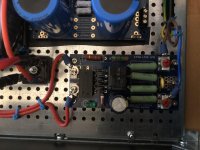The relay contacts are there to bypass the series soft start resistors and are activated by the relay coil .
The relay should be at least 10 amps working and unless I am missing something not seeing a schematic there is not much more to a simple SSR .
There should be some heat from the relay coil but not so hot you cant keep your fingers on it .
It looks like it is built into your amplifier --correct ? --if so it would not get by the British Standards Institute on electrical engineering safety --or is it built into a separate box ?
The relay should be at least 10 amps working and unless I am missing something not seeing a schematic there is not much more to a simple SSR .
There should be some heat from the relay coil but not so hot you cant keep your fingers on it .
It looks like it is built into your amplifier --correct ? --if so it would not get by the British Standards Institute on electrical engineering safety --or is it built into a separate box ?
Hello,
I would measure exactly what the coil voltage is and see if that matches the relays rating. Contacts as Duncan says should be rated for at least ten amps.
I would measure exactly what the coil voltage is and see if that matches the relays rating. Contacts as Duncan says should be rated for at least ten amps.
it is rated for 10A.
It is inside the amplifier cabinet, not in separate box.
I measured the temp, using a ir thermometer
https://cdn.shopify.com/s/files/1/1006/5046/files/SSSchematic.jpg
It is inside the amplifier cabinet, not in separate box.
I measured the temp, using a ir thermometer
https://cdn.shopify.com/s/files/1/1006/5046/files/SSSchematic.jpg
Relay getting hot suggests either,
The coil is getting the wrong voltage, thus heating the coil.
Or
The amp is drawing a lot of power through the contacts, thus heating the contacts.
The coil is getting the wrong voltage, thus heating the coil.
Or
The amp is drawing a lot of power through the contacts, thus heating the contacts.
Increase R1 if the measured voltage across Zener is more than 24V. Basically, increase that resistor to get a stable relay closure and 24V DC across Zener.
If you are getting more than 24V, that is not a good sign... Zener can not regulate the voltage.... which means that the R1 must be increased.
I checked the BOM... I'd expected to see different values for R1 and R2, depending on mains voltage 100/110 or 220/230/240V AC... No?
Also, the relay contacts might not be closing hard enough... this would mean that the voltage across Zener is not high enough (this is very unlikely)... OR the relay is faulty.
It is extremely unlikely the contacts themselves will see anything higher than a few amps.
Later on, once you figured out what's going on with the heat, you could try a different relay; one with split contacts, you'll like the sound better.
EDIT: make sure that there's no ringing at the secondary side of the transformer (oscilloscope); you may need a snubber.
If you are getting more than 24V, that is not a good sign... Zener can not regulate the voltage.... which means that the R1 must be increased.
I checked the BOM... I'd expected to see different values for R1 and R2, depending on mains voltage 100/110 or 220/230/240V AC... No?
Also, the relay contacts might not be closing hard enough... this would mean that the voltage across Zener is not high enough (this is very unlikely)... OR the relay is faulty.
It is extremely unlikely the contacts themselves will see anything higher than a few amps.
Later on, once you figured out what's going on with the heat, you could try a different relay; one with split contacts, you'll like the sound better.
EDIT: make sure that there's no ringing at the secondary side of the transformer (oscilloscope); you may need a snubber.
Last edited:
- no, you should decrease C2.Increase R1 if the measured voltage across Zener is more than 24V.
Relay getting hot suggests either,
The coil is getting the wrong voltage, thus heating the coil.
Or
The amp is drawing a lot of power through the contacts, thus heating the contacts.
Or contacts are arcing.
Sorry for the OT, but had never heard this said before...(snip)Later on, once you figured out what's going on with the heat, you could try a different relay; one with split contacts, you'll like the sound better.
What is a split contact relay?
Google didn't turn any up for me.
How is the sound affected?
Maybe a quieter click, like using a brush on a drum?
Google didn't turn any up for me.
How is the sound affected?
Maybe a quieter click, like using a brush on a drum?
Are waiting for some new C2 capacitors to arrive.
after reading the forum for the 100th time 😀, it seems that a 330nf or 470nf is what i should be using.
Andreas
after reading the forum for the 100th time 😀, it seems that a 330nf or 470nf is what i should be using.
Andreas
Relays take a lot more current to close than to keep them closed. If you run them at rated voltage they're likely to run quite warm. Ideally, you'd arrange a circuit to close the relay with full rated voltage, then reduce it for continuous operation.
What is a split contact relay?
Google didn't turn any up for me.
How is the sound affected?
Maybe a quieter click, like using a brush on a drum?
I think he means -voltage sensing --split CHARGE relays.
- Home
- Amplifiers
- Power Supplies
- Soft start relay is running hot
